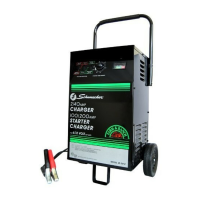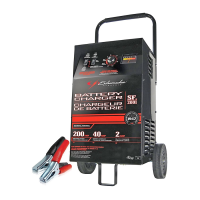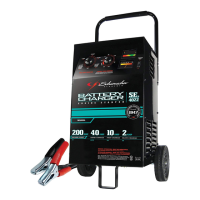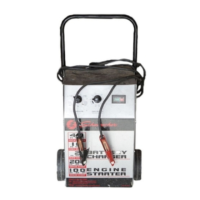1
00-99-000890-0109
OWNER’S MANUAL
READ ENTIRE MANUAL BEFORE
USING THIS PRODUCT
IMPORTANT: READ AND SAVE THIS SAFETY AND INSTRUCTION MANUAL.
IMPORTANT SAFETY INSTRUCTIONS1.
SAVE THESE INSTRUCTIONS1.1 – The SE-1 offers a wide range of features
to accommodate the needs for home use. This manual will show you how
to use your charger safely and effectively. Please read, understand and
follow these instructions and precautions carefully, as this manual contains
important safety and operating instructions.
WARNING:1.2 Pursuant to California Proposition 65, this product contains
chemicals known to the State of California to cause cancer and birth defects
or other reproductive harm.
Do not expose charger to rain or snow.1.3
Use only recommended attachments. Use of an attachment not recom-1.4
mended or sold by Schumacher
®
Electric Corporation may result
in a risk of re, electric shock or injury to persons.
To reduce the risk of damage to electric plug or cord, pull by the plug rather 1.5
than the cord when disconnecting the charger.
An extension cord should not be used unless absolutely necessary. Use of 1.6
an improper extension cord could result in a risk of re and electric shock.
If an extension cord must be used, make sure:
That the pins on the plug of the extension cord are the same number, size •
and shape as those of the plug on the charger.
That the extension cord is properly wired and in good electrical condition.•
That the wire size is large enough for the AC ampere rating of the charger •
as specied in the table in section 8.
Do not operate the charger with a damaged cord or plug; take it to a quali-1.7
ed service person. (Call customer service at: 1-800-621-5485.)
Do not operate the charger if it has received a sharp blow, been dropped 1.8
or otherwise damaged in any way; take it to a qualied service person.
(Call customer service at: 1-800-621-5485.)
Do not disassemble the charger; take it to a qualied service person when 1.9
service or repair is required. Incorrect reassembly may result in a risk of
re or electric shock. (Call customer service at: 1-800-621-5485.)
To reduce the risk of electric shock, unplug the charger from the outlet 1.10
before attempting any maintenance or cleaning. Simply turning off the
controls will not reduce this risk.
WARNING – RISK OF EXPLOSIVE GASES.
WORKING IN THE VICINITY OF A LEAD-ACID BATTERY IS DANGER-
OUS. BATTERIES GENERATE EXPLOSIVE GASES DURING NORMAL
BATTERY OPERATION. FOR THIS REASON, IT IS OF UTMOST IMPOR-
TANCE THAT YOU FOLLOW THE INSTRUCTIONS EACH TIME YOU
USE THE CHARGER.
TO REDUCE THE RISK OF BATTERY EXPLOSION, FOLLOW
THESE INSTRUCTIONS AND THOSE PUBLISHED BY THE BATTERY
MANUFACTURER AND THE MANUFACTURER OF ANY EQUIPMENT
YOU INTEND TO USE IN THE VICINITY OF THE BATTERY. REVIEW
THE CAUTIONARY MARKINGS ON THESE PRODUCTS AND ON THE
ENGINE.
PERSONAL PRECAUTIONS2.
Consider having someone close enough by to come to your aid when you 2.1
work near a lead-acid battery.
Have plenty of fresh water and soap nearby in case battery acid contacts 2.2
skin, clothing, or eyes.
Wear complete eye protection and clothing protection. Avoid touching eyes 2.3
while working near the battery.
If battery acid contacts skin or clothing, wash immediately with soap and 2.4
water. If acid enters eye, immediately ood eye with cold running water for
at least 10 minutes and get medical attention immediately.
NEVER2.5 smoke or allow a spark or ame in vicinity of the battery or engine.
Be extra cautious to reduce the risk of dropping a metal tool onto the bat-2.6
tery. It might spark or short-circuit the battery or other electrical part that
may cause an explosion.
Remove personal metal items such as rings, bracelets, necklaces, and 2.7
watches when working with a lead-acid battery. A lead-acid battery can pro-
duce a short-circuit current high enough to weld a ring or the like to metal,
causing a severe burn.
Use this charger for charging a LEAD-ACID battery only. It is not 2.8
intended to supply power to a low voltage electrical system other than in
a starter-motor application. Do not use this battery charger for charging
dry-cell batteries that are commonly used with home appliances. These bat-
teries may burst and cause injury to persons and damage to property.
NEVER2.9 charge a frozen battery.
PREPARING TO CHARGE3.
If it is necessary to remove the battery from the vehicle to charge it, always 3.1
remove the grounded terminal rst. Make sure all of the accessories in the
vehicle are off, to prevent arcing.
Be sure area around the battery is well ventilated while the battery is being 3.2
charged.
Clean the battery terminals before charging the battery. During cleaning, 3.3
keep airborne corrosion from coming into contact with your eyes, nose and
mouth. Use baking soda and water to neutralize battery acid and help elimi-
nate airborne corrosion. Do not touch your eyes, nose or mouth.
Add distilled water to each cell until the battery acid reaches the level 3.4
specied by the battery manufacturer. Do not overll. For a battery without
removable cell caps, such as valve regulated lead-acid-batteries, carefully
follow the manufacturer’s recharging instructions.
Read, understand and follow all instructions for the charger, battery, vehicle 3.5
and any equipment used near the battery and charger. Study all of the bat-
tery manufacturer’s specic precautions while charging and recommended
rates of charge.
Determine the voltage of the battery by referring to the vehicle owner’s 3.6
manual and make sure that the output voltage selector switch is set to the
correct voltage. If the charger has an adjustable charge rate, charge the
battery in the lowest rate rst.
Make sure that the charger cable clips make tight connections.3.7
CHARGER LOCATION4.
Locate charger as far away from the battery as DC cables permit.4.1
Never place charger directly above the battery being charged; gases from 4.2
the battery will corrode and damage the charger.
Do not set the battery on top of the charger.4.3
Never allow the battery acid to drip onto the charger when reading the 4.4
electrolyte specic gravity or lling the battery.
Do not operate the charger in a closed-in area or restrict ventilation in any 4.5
way.
DC CONNECTION PRECAUTIONS5.
Connect and disconnect the DC output clips only after removing the AC plug 5.1
from electric outlet. Never allow the clips to touch each other.
Attach the clips to the battery and chassis, as indicated in steps 6.5, 6.6, 5.2
and 7.2 through 7.4.
FOLLOW THESE STEPS WHEN BATTERY IS INSTALLED IN 6.
VEHICLE.
A SPARK NEAR THE BATTERY MAY CAUSE A BATTERY EXPLOSION.
TO REDUCE RISK OF A SPARK NEAR BATTERY:
Position the AC and DC cords to reduce the risk of damage by the hood, 6.1
door, and moving or hot engine parts.
Model SE-1
Manual Battery Charger
Voltage: 12
Amperage: 1












